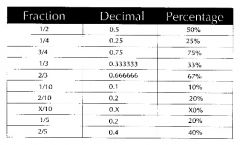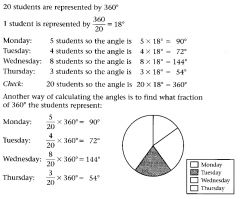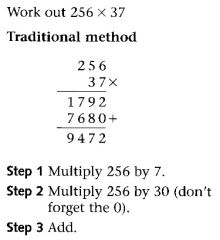![]()
![]()
![]()
Use LEFT and RIGHT arrow keys to navigate between flashcards;
Use UP and DOWN arrow keys to flip the card;
H to show hint;
A reads text to speech;
32 Cards in this Set
- Front
- Back
- 3rd side (hint)
|
What are square numbers?
|
A number that can be expressed as the product of multiplying two equal numbers (e.g. 36=6x6)
|
|
|
|
What are cube numbers?
|
A number that can be expressed as the product of multiplying three equal numbers (e.g. 77=3x3x3)
|
|
|
|
What are triangle numbers?
|
A number that can be represented by a triangular array of dots with the
number of dots in each row from the base decreasing by one. |
|
|
|
How do you multiply fractions?
|

|
|
|
|
How do you divide fractions?
|

|
|
|
|
How do you cancel down fractions?
|

|
|
|
|
How do you add/subtract fractions?
|

|
|
|
|
How do you find the fraction of something?
|

|
|
|
|
How do you order fractions?
|

|
|
|
|
What are the common conversions of Fractions, Decimals and percentages?
|

|
|
|
|
How do you convert a Fraction to a Decimal?
|
Divide the top number of the fraction by the bottom number of the fraction.
|
|
|
|
How do you convert a Decimal to a Percentage?
|
Multiply by 100.
|
|
|
|
How do you convert a Percentage to a Decimal?
|
Divide by 100.
|
|
|
|
How do you convert a Terminating Decimal to a fraction?
|

Put the number after the decimal point as the top number of the fraction, then place a 1 followed by the same amount of 0's as there are digits after the decimal point on the bottom of the fraction.
|
|
|
|
How do you convert a recurring Decimal to a fraction?
|

|
|
|
|
What are the two types of data and how do they differ?
|
>Quantitative - numerical data
>Qualitative - not numerical. |
|
|
|
What are the two types of quantitative data and how do they differ?
|
>Continuous - can have any value and is usually measured, e.g. temperature, length
>Discrete - can only take certain values, e.g. shoes sizes, population. |
|
|
|
Define data?
|
Information being collected.
|
|
|
|
Define population?
|
All the possible data that can be collected for the survey.
|
|
|
|
Define sample?
|
Information taken from just part of the population.
|
|
|
|
Define census?
|
When the entire population is used for the survey.
|
|
|
|
Define bias?
|
If an adequate sample is not taken then the results might be biased.
|
|
|
|
Define random sampling?
|
Data is collected randomly.
|
|
|
|
Define systematic sampling?
|
Data is collected according to some rule, e.g. every 10th item of data.
|
|
|
|
Define quota sampling?
|
The population is divided into groups or categories and certain numbers from each will be surveyed.
|
|
|
|
Define stratified sampling?
|
The population is divided into groups or categories (strata) and a random sample is taken from each category in proportion to the size of the category.
|
random, size
|
|
|
What are the 5 types of chart?
|
>Vertical bar chart
>Horizontal bar chart >Pie chart >100% chart >Pictogram |
|
|

State the steps to find the angle for pie charts.
|

|
|
|
|
What is the written method for adding?
|

|
|
|
|
What is the written method for subtracting?
|

|
|
|
|
What is the written method for multiplying?
|

|
|
|
|
What is the written method for dividing?
|

|
|

